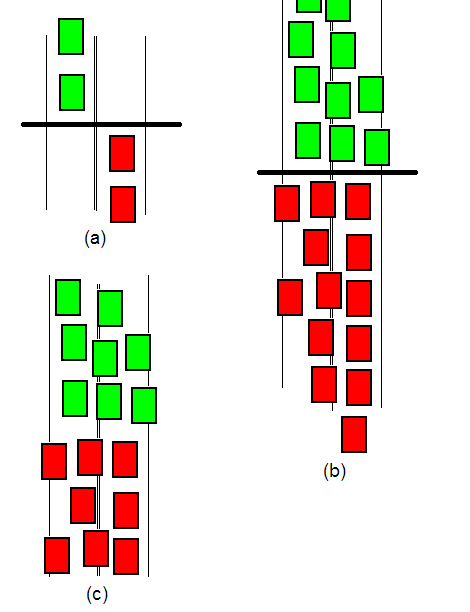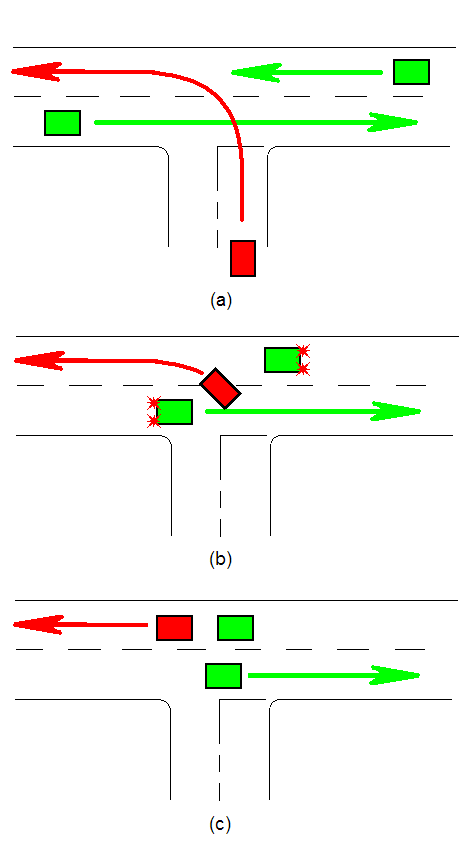Traffic modelling hack - how to modify your traffic modelling software to simulate traffic conditions in Tianjin
If there is a need to model traffic in Tianjin using agent-based modelling, the following characteristics are recommended for the agents:
Below are several verifying tests you can perform to check that your model has captured the essence of Tianjin traffic:
Railway level-crossing
Create a single carriageway with two lanes – one north bound and the other south bound. Ensure that there is no physical divider between the lanes, and that double continuous lines separate the lanes, indicating that drivers may neither overtake nor encroach into the opposing lane.
Set the traffic density to a moderate level. To create the level-crossing, create a temporary obstruction across the road, to model the crossing being closed for the passage of a train.
Upon creation of this barrier, cars should start to accumulate and form a queue behind the obstruction (see figure 1a). When the queue length reaches approximately 5 cars, some cars will attempt to jump the queue by lining up on the opposite lane. Shortly after, you will observe that approximately 3 indistinctive queues have formed across the entire road. This happens on both sides (see figure 1b).

Figure 1.
When the obstruction is removed (when the train has passed without incident), the resulting blockage will take a significant time to clear (see figure 1c). This typically ranges from 2 to 5 minutes.
If your model recreates this scenario, it suggests you have successfully incorporated “no long term foresight” and “no adherence to lane rules” into your model. The first is demonstrated when agents insist on piling up on the wrong lane just to be ahead by several metres, but resulting in massive delays. The second is also demonstrated when agents pile up on the wrong lane.
T-junction
Create a T junction be connecting the end of a single carriageway to the middle of another single carriageway.
Create an agent (red) travelling along the tributary road to the main road, such that the agent’s destination is to turn left. Populate the main road with other agents (green), and set their destinations to be straight ahead (see figure 2a).
The red agent will approach the junction and proceed without stopping. On seeing the red vehicle entering their lane, the green agents will slow down (or stop) to avoid colliding into the red agent (see figure 2b).

Figure 2.
If your model recreates this scenario, it suggests you have successfully incorporated “no adherence to right-of-way rules” into your model. This is demonstrated when the red agent obnoxiously enters the main road without giving way or stopping, and relying on others to see it and react accordingly.
Multi-lane expressway
Create an expressway with 2 or 3 lanes going in each direction. Populate the expressway with a variety of vehicles, such as heavy good vehicles, trucks and passenger vehicles with a variety preferred travelling speeds.
Observe that vehicles will travel on arbitrary lanes, irrespective of speed. Also observe a proportion of vehicles will drift between two lanes. If your model recreates this scenario, it suggests you have successfully incorporated “no adherence to lane rules” into your model.
A corollary of this is that vehicles with a faster preferred speed will need to weave between lanes to overtake slow vehicles that occupy various lanes. Also, when traffic density increases slightly, the expressway quickly becomes congested as clusters of slow-moving vehicles prevent other vehicles from travelling at their desired speed.
If your model is able to predict all three phenomenon, congratulations, you have set up your traffic modelling package to simulate Tianjin traffic behaviours.
- No long term foresight
- No adherence to lane rules
- No adherence to right-of-way rules
Below are several verifying tests you can perform to check that your model has captured the essence of Tianjin traffic:
Railway level-crossing
Create a single carriageway with two lanes – one north bound and the other south bound. Ensure that there is no physical divider between the lanes, and that double continuous lines separate the lanes, indicating that drivers may neither overtake nor encroach into the opposing lane.
Set the traffic density to a moderate level. To create the level-crossing, create a temporary obstruction across the road, to model the crossing being closed for the passage of a train.
Upon creation of this barrier, cars should start to accumulate and form a queue behind the obstruction (see figure 1a). When the queue length reaches approximately 5 cars, some cars will attempt to jump the queue by lining up on the opposite lane. Shortly after, you will observe that approximately 3 indistinctive queues have formed across the entire road. This happens on both sides (see figure 1b).

Figure 1.
When the obstruction is removed (when the train has passed without incident), the resulting blockage will take a significant time to clear (see figure 1c). This typically ranges from 2 to 5 minutes.
If your model recreates this scenario, it suggests you have successfully incorporated “no long term foresight” and “no adherence to lane rules” into your model. The first is demonstrated when agents insist on piling up on the wrong lane just to be ahead by several metres, but resulting in massive delays. The second is also demonstrated when agents pile up on the wrong lane.
T-junction
Create a T junction be connecting the end of a single carriageway to the middle of another single carriageway.
Create an agent (red) travelling along the tributary road to the main road, such that the agent’s destination is to turn left. Populate the main road with other agents (green), and set their destinations to be straight ahead (see figure 2a).
The red agent will approach the junction and proceed without stopping. On seeing the red vehicle entering their lane, the green agents will slow down (or stop) to avoid colliding into the red agent (see figure 2b).

Figure 2.
If your model recreates this scenario, it suggests you have successfully incorporated “no adherence to right-of-way rules” into your model. This is demonstrated when the red agent obnoxiously enters the main road without giving way or stopping, and relying on others to see it and react accordingly.
Multi-lane expressway
Create an expressway with 2 or 3 lanes going in each direction. Populate the expressway with a variety of vehicles, such as heavy good vehicles, trucks and passenger vehicles with a variety preferred travelling speeds.
Observe that vehicles will travel on arbitrary lanes, irrespective of speed. Also observe a proportion of vehicles will drift between two lanes. If your model recreates this scenario, it suggests you have successfully incorporated “no adherence to lane rules” into your model.
A corollary of this is that vehicles with a faster preferred speed will need to weave between lanes to overtake slow vehicles that occupy various lanes. Also, when traffic density increases slightly, the expressway quickly becomes congested as clusters of slow-moving vehicles prevent other vehicles from travelling at their desired speed.
If your model is able to predict all three phenomenon, congratulations, you have set up your traffic modelling package to simulate Tianjin traffic behaviours.
Labels: China, how-to, observations

<< Home